Is it worth looking forward to halving the Litecoin in August? One article says throughlite
On June 22, Bitcoin broke through the $10,000 mark, more than three times the price at the beginning of the year. For a time, the topic of “whether the bull market has already started” has once again become a hot topic.
Looking back now, I took the lead in breaking the "falling down" since last year's bear market. The first shot of this year's mainstream currency market is actually Litecoin (LTC) . On February 8th, Litecoin quickly rose by nearly 23%. The market value of the next day surpassed EOS and ranked fourth in the market capitalization list (currently the fifth). Over the past six months, the price of Litecoin has been rising overall, with a maximum break of $141, up 470% from the price of around $30 at the beginning of the year. 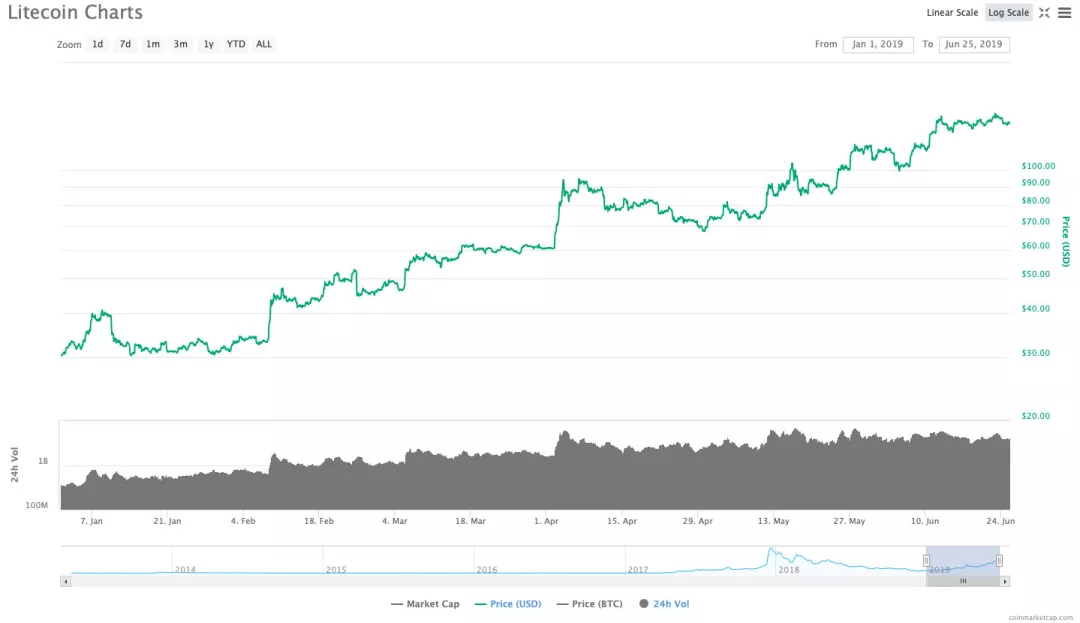
▲ 2019 Litecoin price chart source: CoinMarketCap
For the rising price of Litecoin, many veterans in the industry attribute it to the expectation of halving the block reward in August this year; many people who have just been in contact with the blockchain may only stay in the "bit" Gold, Wright silver" slogan.
- India’s regulation is counterproductive, with a local BTC premium of over $800
- How to catch the big bull market? Demystifying the 3 rules of BTC bull and bear cycle
- Why at this stage of the bull market, most altcoins do not run bitcoin
How does the Litecoin, which is not even white papers, cross the bulls and bears to become the top ten cryptocurrency in the world?
01 The origin of Litecoin
In 2011, because Bitcoin was widely used by some media in the dark network, the term Bitcoin began to move from the world of computer geeks to the public.
A small group of people who are curious about new things learned about Bitcoin during this period, including the well-known Ethereum (ETH) founder V God, the founder of Bitland, Wu Jihan, Babbitt. Founder Chang Hao, and Li Qiwei, the founder of Liteco, which we will introduce today.
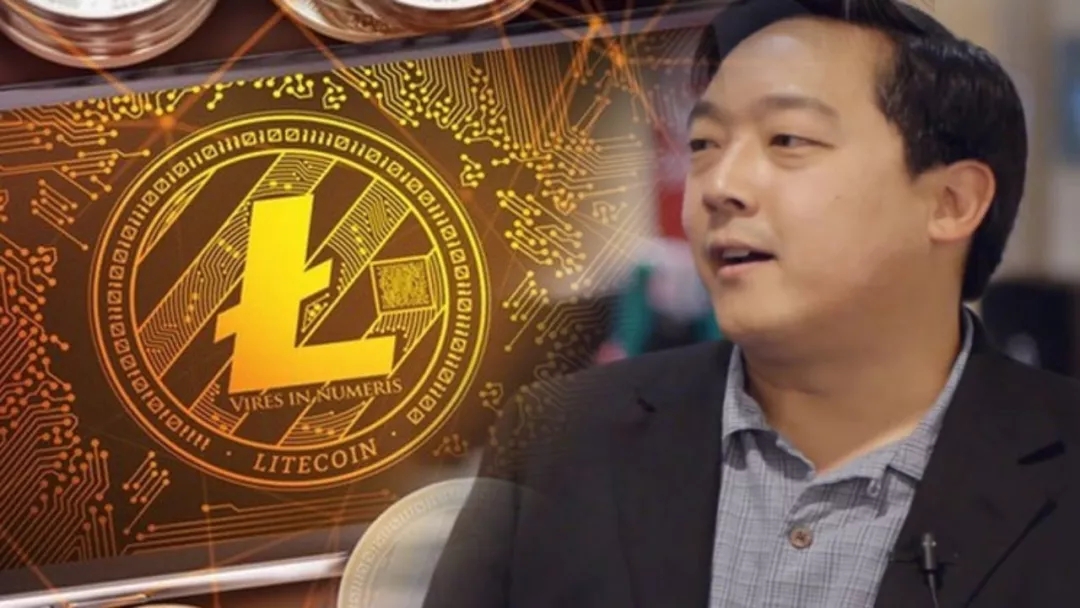 ▲ Lite Capital founder Li Qiwei
▲ Lite Capital founder Li Qiwei
Charlie Lee is a Chinese-American programmer. He also worked at Google in 2011. After learning about Bitcoin from media reports, he bought some bitcoins and used computers to participate in Bitcoin mining.
At the time, many computer geeks either came out of fun (looking cool) or introduced various cryptocurrencies (cottage coins) for the sake of improving Bitcoin's flaws. As a programmer, Li Qiwei also cloned the source code of the Aenecoin Tenebrix and created a new altcoin Fairbix. However, due to the immature technology and other reasons, this altcoin coin project died early.
After summarizing the reasons for the failure, Li Qiwei led the team to clone the core source code of Bitcoin. After making some adjustments, it launched a new cryptocurrency, Litecoin.
02 What is Litecoin
Litecoin, the English name Litecoin, shorthand LTC, and a Chinese nickname "spicy strip". 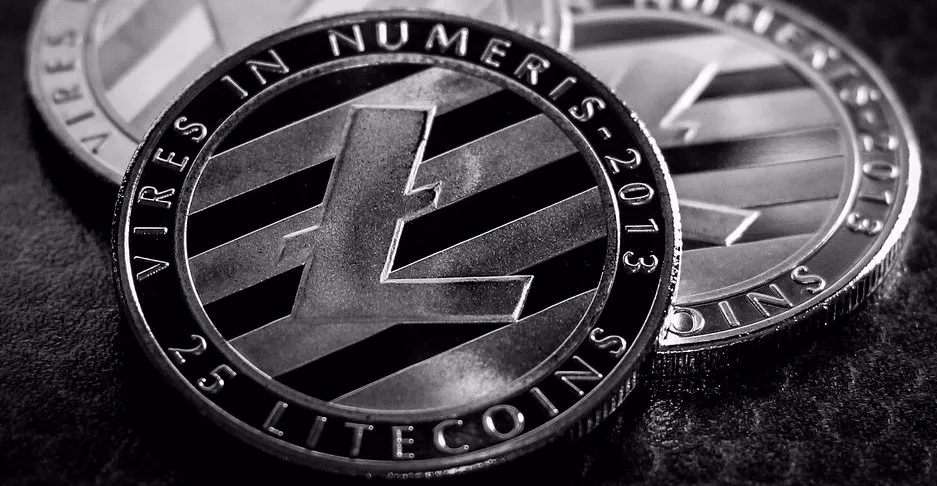
Litecoin has no white papers, and for a long time it has been called "the bitcoin of the Bitcoin." Because it is the core source code for cloning Bitcoin, Litecoin is similar to Bitcoin in many respects, including the PoW consensus mechanism. The block rewards are initially 50, all of which are reduced by about half every four years. Until all the Litecoin coins are dug out.
"Bit Gold, Wright Silver", the original intention of Litecoin is to create a lightweight Bitcoin (A Lite Version of Bitcoin), focusing on daily micropayments. To this end, Litecoin has made adjustments in three areas:
First, for faster transaction confirmation, Litecoin has adjusted the average block time to 2.5 minutes, which is a 4x increase over Litecoin's average of 10 blocks per 10 minutes;
Second, the expected total amount of Litecoin is 84 million, which is a four-fold increase compared to the 21 million bits of Bitcoin;
Third, the Litecoin uses the Scrypt algorithm, which relies on a large amount of memory, as proof of its mining work. The mining threshold is lower than the bitcoin.
Simply put, compared to Bitcoin, the total amount of Litecoin is larger, the transfer speed is faster, and the handling fee is lower.
03 Lite's development
On October 8, 2011, the first block of Litecoin was born; on October 13, Litecoin was officially launched.
In 2013, the bull market in the cryptocurrency market, the Litecoin was widely spread by the community, and its price also increased by more than 80 times with Bitcoin, rising to the highest point of the year – more than 380 yuan. Subsequently, the entire cryptocurrency market suffered the first big bear market in history, and the price of Litecoin was directly swayed.
The skyrocketing and plunging, the trading platform saw the market heat of Litecoin, more and more trading platforms began to launch Litecoin, and Litecoe became the second-largest cryptocurrency at that time, second only to Bitcoin.
For blockchains that use the PoW consensus mechanism, computing power is a guarantee of their security. Unlike Bitcoin's SHA256 mining algorithm, Litecoin is the first cryptocurrency to use the Scrypt algorithm, and its computing power has historically faced severe challenges.
The Dogecoin, which was born on December 12, 2013, also uses the same Scrypt algorithm as Litecoin. In 2014, dog money suddenly became hot in the market. Due to the same mining algorithm, Litecoin and Dogeco coin produced mining competition. Later, the dog's coin passed through the hard fork and enabled the joint mining that was compatible with Litecoin. That is to say, the Treaco coin was also able to obtain the dog currency, and the battle of computing power came to an end.
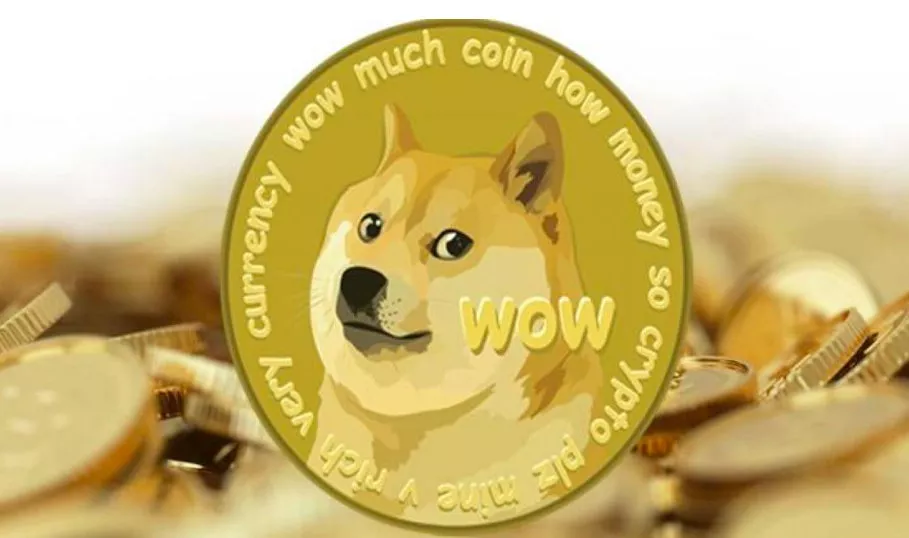 ▲Dogecoin
▲Dogecoin
On July 3, 2016, the Litecoin Development Team and the Litecoin Foundation jointly released the “Lite Currency Official 2016 Development Roadmap”, which announced that it will release “Separation Witness”, “Lightning Network”, “Smart Contract”, etc. A new version of the feature. On May 11, 2017, the Quarantine Witness was officially activated on the Litecoin, and users could use the quarantine witness to use this new trading method on Litecoin; on June 21, 2017, Li Qiwei officially announced the Wright Lightning Network online. The goal is to achieve secure under-chain transactions.
These new technologies, which were originally expected to be applied in Bitcoin, were the first to be tested by Litecoin, so Litecoin is known as the “test piece of new technology for Bitcoin”. On January 7, 2017, Li Qiwei issued a letter expressing the role of Litecoin as a new feature in Bitcoin testing, saying that the two will jointly solve the problem of future cryptocurrency payments.
2017 is a big bull market for cryptocurrencies, and the price of Litecoin has risen more than 90 times from the beginning of the year. In December, Li Qiwei sent a tweet to remind the risk that the Litecoin might plummet to $20 in the bear market that followed. 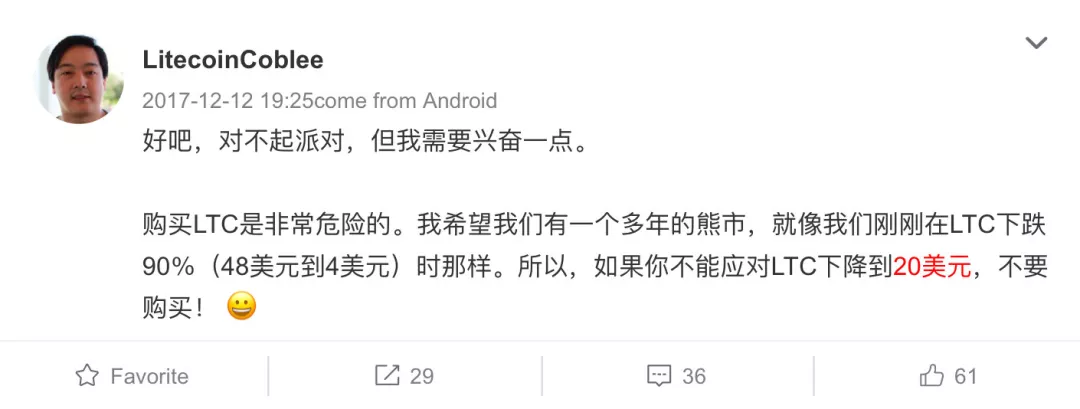
On December 12th, Litecoin hit a record high of $420, and soon Li Kaiwei announced the clearance of all Litecoin in his hand. Since then, in 2018, with the arrival of the bear market, the price of Litecoin has plummeted, dropping to a minimum of $22, which is only $2 from the price predicted by Li Qiwei.
Li Qiwei’s “escape from the top” caused a lot of confusion in the community, and the suspicion of “Li Qiwei’s high cash out” was heard. Li Qiwei subsequently clarified that “the liquidation of Litecoin does not want his voice to be tied up by the interests of Litecoin. ” He hopes to concentrate on the future and push the Litecoin to continue to grow.
04 What is Litecoin doing now?
On January 3 this year, Li Qiwei posted that "the next battlefield will be replaceability and privacy ." 
Fungibility means that every currency, no matter who has owned it, no matter what trading history it has, the theoretical value is the same and can be replaced. For example, the 1LTC in Zhang San's wallet and the 1LTC in Li Si's wallet should be completely equivalent and can be replaced.
Blockchain technology makes transactions transparent and traceable, which to some extent undermines the substitutability of cryptocurrencies . For example, some digital money service providers will detect the trading history of cryptocurrencies and impose restrictions on cryptocurrencies that have had bad records. Take the Litecoin as an example. Suppose a miner has dug up a block and was rewarded with 25 LTC. The miners spent the 25 LTC. These Litecoin entered the dark net, the black market in circulation, and then circulated out, 1LTC Entered Zhang's account. Although this 1LTC was bought by Zhang San with his own pocket money, it is a “pollution” of Litecoin, which may be restricted by digital money service providers, and may not be equal to 1LTC in Li Si wallet. Values, can't replace each other. This is why the new currency (the currency that miners have just dug) tends to have a certain premium.
So how to solve the replacement problem of Litecoin?
Li Qiwei and the Litecoin development team set their sights on the underlying protocol of the anonymous coin Grin, the MimbleWimble protocol. Use this technology to expand the block, use MimbleWimble as a side chain, and finally realize that Litecoin can be sent to the MimbleWimble expansion module or sent back to the main chain to enhance the anonymity and replaceability of Litecoin.
In addition to increasing anonymity, Litecoin is more replaceable, and ongoing technology developments include: Lightning Networks, and a decentralized trading platform based on atomic switching.
Lightning networks can be simply understood as adding a layer of blockchain (Layer 2) to handle transactions. This makes Liteco's transactions faster, less expensive, more scalable, and more suitable for initial positioning – with a focus on daily micropayments.
At present, most of Lightx's lightning network development work has been completed, and it is necessary to further improve the user experience. According to the statistics of the 1ML website, as of June 25, the number of lightning network nodes of the Litecoin reached 204, the number of channels was 1,203, and the number of locked Litecoins was 288.29. 
Based on the atomic exchange-based decentralized trading platform, the more famous one is Sparkswap. Sparkswap is Bitcoin's first decentralized trading platform that utilizes lightning network atomic exchange and currently only offers BTC/LTC trading pairs.

05 Litecoin halved
For Litecoin, the most important thing for investors in the industry today is that it is expected to happen on August 5th (block height of 1680000). At that time, the Lite Prize block will change from the current 25LTC to 12.5LTC.

The block reward is halved, and the biggest impact is the miners. After the 5% reduction in the Litecoin block award, if the calculation and mining difficulty remain the same, the cost of mining will double for the miners.
In addition, a halving of mining incentives will reduce the inflation rate of Litecoin. At present, the inflation rate of Litecoin is about 8.3%. After the mining incentives are halved in August, the inflation rate will drop to about 4.2%.
The halving of the Litecoin mining incentives will also affect the supply and demand relationship in the market. In economics, it is generally believed that prices are determined by supply and demand. If demand is constant, supply will decrease and prices will rise. Based on this, many investors have come to the conclusion that the price of the Wright coin mining reward will increase after halving. Is it really valid?
Historically, Bitcoin has experienced two block rewards halved. In November 2012, the Bitcoin block reward experience was halved for the first time. After one year, the bitcoin price exceeded $1,000, a record high. In July 2016, the Bitcoin block reward was halved for the second time, followed by one year. (2017) Bitcoin prices rose all the way, eventually breaking through $20,000. The next halving of Bitcoin will occur in May next year (2020).
Litecoin has only experienced a halved block award in history, which occurred in August 2015. In January 2015, the price of Litecoin bottomed out, and the expectation of halving the block reward led to the rise of Litecoin three months ahead of schedule. After the block reward was halved, the price actually began to fall. 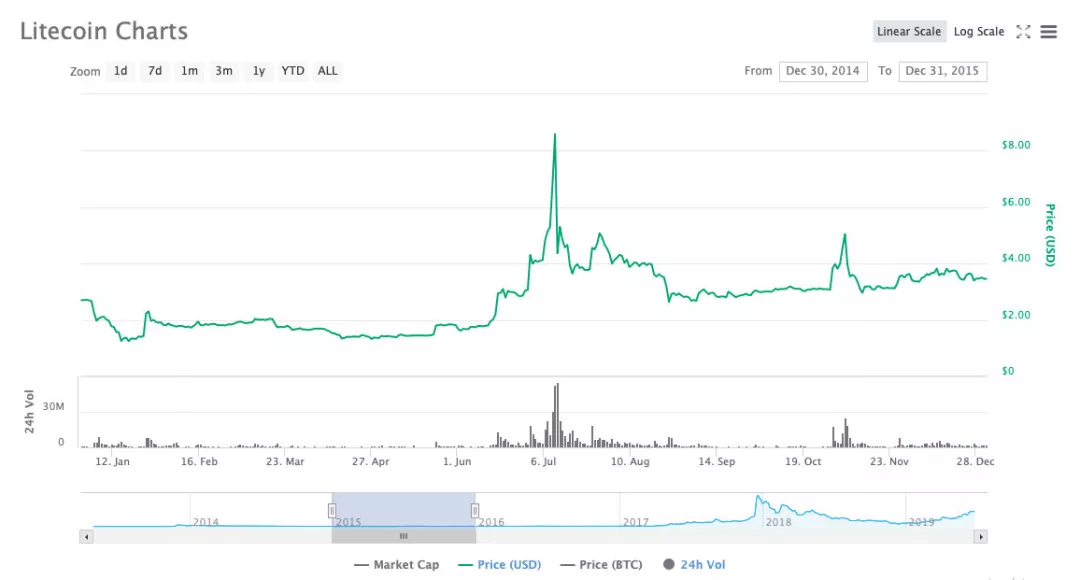
▲ Litecoin's price chart for 2015 Source: CoinMarketCap
There is a cyclicality in any investment market, and real trends often need to be revealed after multiple cycles (at least 2). Bitcoin only experienced two block rewards halved, and Litecoin experienced a block reward halved. From a statistical point of view, the data sample is too small to support the conclusion that “the mining reward will be halved and the price will rise”. .
Moreover, the cryptocurrency market is very immature and full of various uncertainties, and the "black swan" incident may occur at any time. Even if one step back, there is really a so-called "half-price". At present, the price of the Litecoin has increased more than four times compared with the beginning of the year, and the risk is constantly expanding.
05 summary
Although Litecoin has no white papers and no long-term roadmap, its positioning is clear –making a "lightweight bitcoin", focusing on everyday smalls through faster transaction speeds and cheaper transaction fees. The cryptocurrency paid is the same as its slogan "Bit Gold, Wright Silver".
Since the birth of Bitcoin, there have been many cryptocurrencies in the market. A large part of it has disappeared. The Litecoin has withstood the baptism of the bear market. So far, it is still ranked in the top ten global market capitalization. Not much mainstream "old coins".
However, with the development and advancement of Bitcoin Lightning Network, Bitcoin's micropayment function has become more and more powerful, and many people have begun to question the necessity of the existence of Litecoin. Even as a “test piece of bitcoin new technology”, is a trial product really worth more than $8 billion in market capitalization? Everything has time to give us the answer.
No. 263: Do you think that the existence of Litecoin is necessary? why? Feel free to share your opinion in the message area.
——End——
Original: JackyLHH
Source: vernacular blockchain
『Declaration : This article is the author's independent point of view, does not represent the vernacular blockchain position, and does not constitute any investment advice or advice. 』
We will continue to update Blocking; if you have any questions or suggestions, please contact us!
Was this article helpful?
93 out of 132 found this helpful
Related articles
- Global Times English: China cannot be absent from the digital currency era
- Zhu Jiaming: Don't ignore the capital behind Facebook, and don't underestimate Libra's technology.
- Oracle Announces Support for More Than 50 Startups Accessing Chainlink Predictor for Data Realization
- Market Analysis: BTC continues to break through the new high, and the right side will appear to accelerate the market?
- Beyond Bakkt? LedgerX approved to launch physical bitcoin futures contract
- JPMorgan Chase: It is expected to start testing JPM Coin at the end of this year
- Getting started with blockchain | Do you know the 50 blockchain terms? (on)






